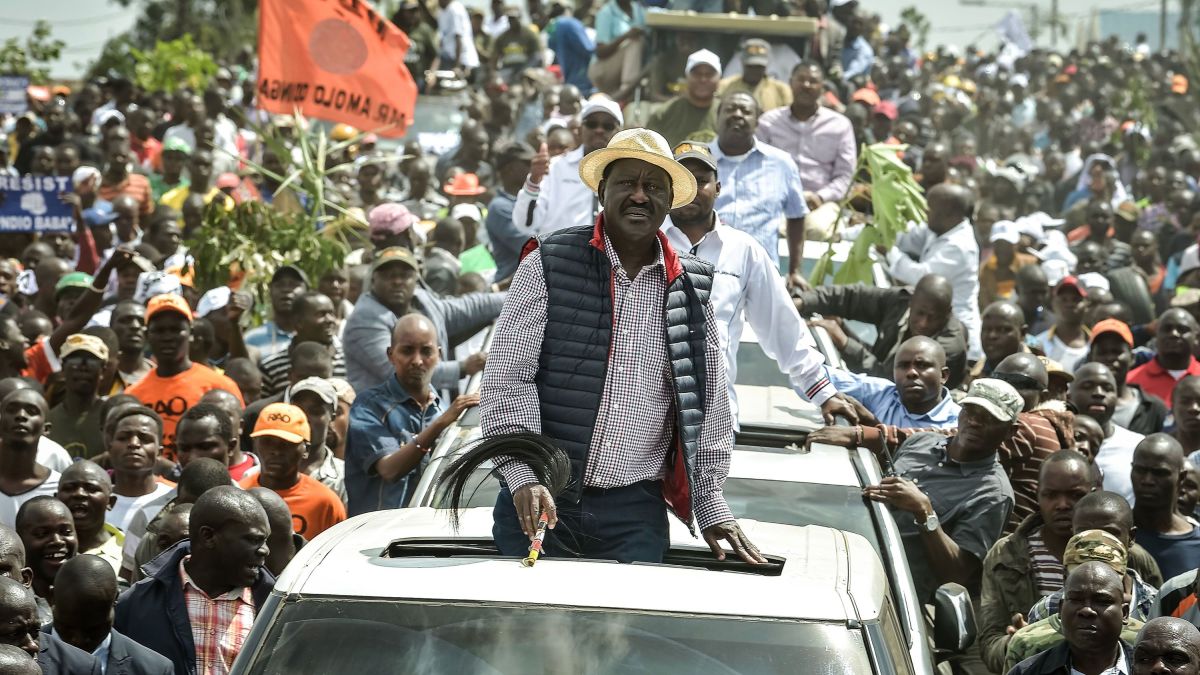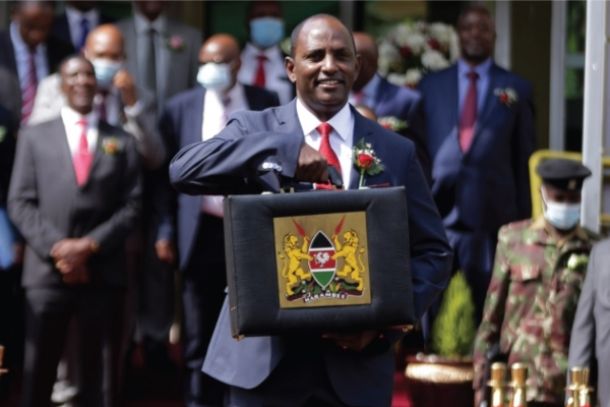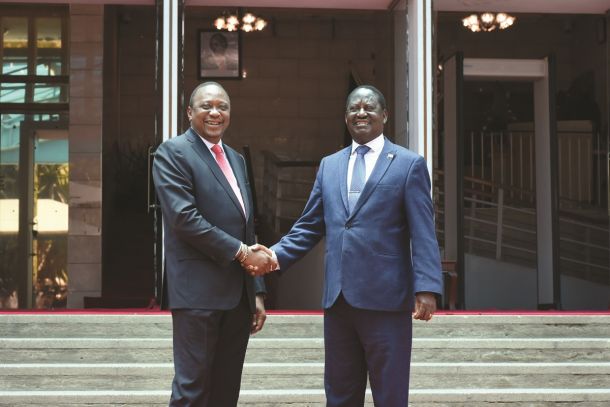Kenyan protests to resume after Ramadan, as talks break down between government and opposition
No respite for Ruto as opposition protesters return to the barricades. By Zachary Ochieng in Nairobi.

Kenyan opposition leader Raila Odinga pictured during the 2022 election, which he disputes the result of.
The street protests that brought Kenya to a halt throughout March are set to continue for the foreseeable future, after opposition leaders announced they would resume their campaign after Ramadan.
Many streets in Kenya’s big cities were no-go zones for much of March as police battled with angry and, in many cases, violent protestors.
The crowds had responded to calls for mass action by opposition leader Raila Odinga.
The veteran politician, who stood as the 2022 presidential candidate for the Azimio La Umoja – or One Kenya – coalition, cited Kenya's spiralling cost of living, President William Ruto’s failure to implement his election campaign promises, and the government’s decision to pack the Independent Electoral and Boundaries Commission (IEBC) selection panel with its ‘friends’ as reasons for the protests.
He also called for ethnic and regional balance in state and civil service appointments, and the shelving of plans to allow genetically modified foods and seeds to be imported into Kenya.
The current crisis has been a long time brewing.
Odinga and his coalition colleagues held a series of countrywide rallies in the run-up to the March disturbances, calling on their supporters to reject the current government, which they described as ‘illegitimate’.
In January, Odinga claimed he had been given a leaked dossier from an IEBC whistleblower indicating that he, not Ruto, had won the August 2022 presidential polls.
The report alleged that he had received more than eight million votes in last year’s vote, compared to just 5.9 million for Ruto.
According to official results declared by the IEBC boss, Wafula Chebukati, President Ruto garnered 7,176,141 votes against Odinga’s 6,942,930 votes. Odinga now wants the IEBC’s server results to be made public.
To compound matters, four of the seven IEBC commissioners distanced themselves from the official results last year when they were announced by the chairman and two commissioners.
The main reason why the protests drew such large crowds, however, was the spiraling cost of living. Odinga has criticised the government for removing existing subsidies on basic products like fuel and maize flour, Kenya’s staple food, describing it as ‘reckless and heartless’.
‘We must cushion our people against the high cost of living by returning subsidies that were put in place [before Ruto took power in September last year]. The subsidies must be restored, and the cost of basic commodities and taxes must come down in the next 14 days,’ Odinga said during one of his rallies in February.
To combat Kenya’s cost of living crisis President Ruto has proposed fertiliser subsidies to boost food cultivation and help bring down the cost of production.
But it is not just the cost of food that has gone up. Electricity costs have also risen by 63 per cent after the energy regulator approved higher tariffs.
Taxes have also been increased substantially.
Ruto’s Kenya Kwanza regime promised to adopt austerity measures upon assuming office, but it has also come under heavy criticism for reckless spending.
The president’s office, for instance, has spent its first year’s budget in just seven months.
In a bid to reward his friends and cronies, the president has appointed 50 people to an unconstitutional office known as Chief Administrative Secretary (CAS), at a total cost of $45.9 million in salaries and allowances annually.
But that’s not all. For the first time in Kenya’s independent history, civil servants had their March salaries delayed in what critics attribute to the government’s reckless spending, including unnecessary foreign trips, top of the range cars and the establishment of offices for spouses of the deputy president and the prime cabinet secretary.
On February 22, Odinga gave the Ruto administration a 14-day ultimatum to address increases in living costs and publish data from the IEBC server for the August 2022 vote.
When that deadline elapsed, the opposition leader announced March 20 as the first day of civil disobedience, calling on his supporters throughout the country to ‘stage a massive procession in Nairobi for a legitimate and inclusive government’.
Thousands of Kenyans heeded the veteran opposition leader’s calls for anti-government protests that were initially held on Mondays but were escalated to Mondays and Thursdays in the second week.
Odinga had said he would march with his supporters to State House to deliver a memorandum to Ruto.
Despite a government ban on demonstrations, protestors swarmed the streets of Nairobi and Kisumu, Odinga’s home city. Businesses remained closed as transport was paralysed.
However, the protests quickly turned violent.
Demonstrators began blocking roads and burning tyres, leading to clashes with police.
The police response was heavy-handed, with officers using tear gas and live ammunition to disperse the crowds. The police also targeted journalists that were covering the protests, injuring several of them and destroying their equipment. Several journalist unions condemned the attacks.
At the end of two weeks of protests, at least six Kenyans, including a police officer, were dead.
More than 400 were injured in the protests, including at least 60 members of the security services.
A church and a mosque were burned down in Kibera, one of Odinga’s strongholds on the outskirts of Nairobi.
Shops, supermarkets and a mortuary were looted, and police vehicles were torched or hijacked.
The country’s economy was hit hard as many businesses remained closed throughout the protest days.
The country also witnessed a Zimbabwe-like situation when goons raided former president Uhuru Kenyatta’s private farm.
They slaughtered animals, carted away others, sub-divided the land and even put up structures as police stayed away.
Odinga’s gas cylinder manufacturing plant, East African Spectre, was also attacked.
The raids were preceded by remarks by Parliamentary Majority leader Kimani Ichung’wa, a strong Ruto ally, who claimed Kenyatta was funding the protests and should have his vast farms raided.
With the economy in free fall, President Ruto agreed to a dialogue with the opposition at the start of April.
He proposed a bipartisan parliamentary committee to select new IEBC commissioners. Odinga agreed to call off the demonstrations but insisted the committee be established immediately.
The government and opposition sides have each selected seven members to sit on the committee.
But even before the committee begins its work, the government side has returned to its hardline stance, with Ruto’s allies saying they will only discuss the reconstitution of IEBC.
This has irked the opposition, who announced a return to protests at the end of the Islamic holy month of Ramadan on April 21.
Odinga, who has led the opposition under successive governments, has a long history of using mass mobilisation and the paralysis it causes to get his way.
In 1997, the former president Daniel Moi, tired of Odinga’s protests, gave in to his demands for constitutional reforms and co-opted Odinga’s National Development Party (NDP) into government.
When Odinga lost the disputed presidential election to Mwai Kibaki in 2007, his supporters took to the street in a bloody episode that led to the death of over 1,000 civilians and the displacement of 600,000 Kenyans due to inter-ethnic violence.
The international community mediated a peace deal that saw Odinga and Kibaki share power, with the former as prime minister and the latter as president.
In 2017, Odinga ran against Uhuru Kenyatta, disputed the results, illegally swore himself in as the ‘People’s President’ and led protests that paralysed the country for weeks.
Kenyatta gave in and agreed to a rapprochement with Odinga in what became known as the ‘Handshake’.
Though not officially in government, Odinga wielded a lot of influence, including over a number of state appointments.
His Nyanza region also receiving several development projects.
It is this kind of arrangement that the Ruto regime believes Odinga is looking for with his ongoing street protests. But only time will tell.
Kenya grapples with debt crisis
As Kenya’s lockdown bills skyrocket, the country is faced with a new era of austerity, government borrowing and tax hikes. By Zachary Ochieng in Nairobi.
Over 160,000 Kenyans signed an online petition in April to stop the International Monetary F...
Kenyan leaders sue for peace
A surprise unity pact between Uhuru and Raila offers new hope for a divided nation.
Kenyans are looking forward to greater political and economic stability following the March 9 truce between President Uhuru Kenyatta and opposition leader Raila O...





